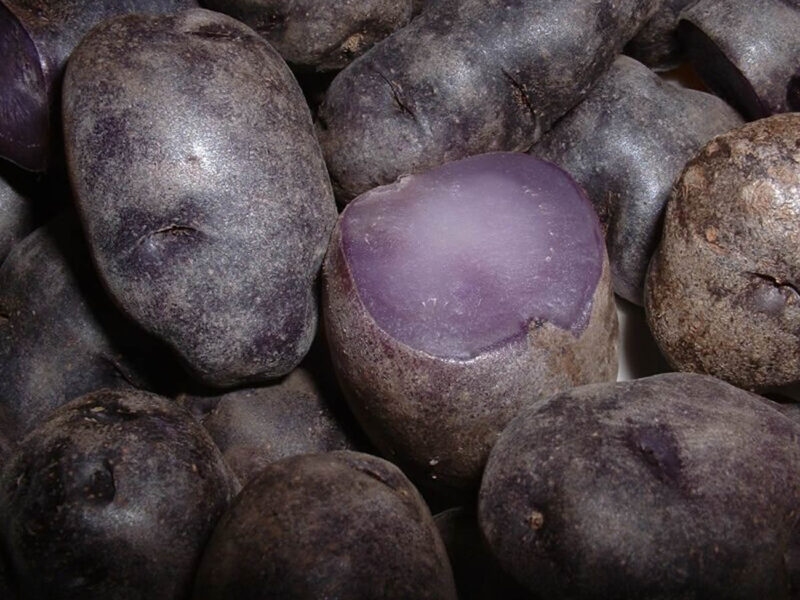Compounds found in purple potatoes may help kill colon cancer stem cells and limit the spread of the cancer, according to a team of researchers.
Baked purple-fleshed potatoes suppressed the growth of colon cancer tumors in petri dishes and in mice by targeting the cancer’s stem cells. Colon cancer is the second leading cause of cancer-related deaths in the U.S. and responsible for more than 50,000 deaths annually, according to the American Cancer Society.
Attacking stem cells is an effective way to counter cancer, according to Jairam K.P. Vanamala, associate professor of food sciences, Penn State and faculty member, at the Penn State Hershey Cancer Institute.
“You might want to compare cancer stem cells to roots of the weeds,” Vanamala said. “You may cut the weed, but as long as the roots are still there, the weeds will keep growing back and, likewise, if the cancer stem cells are still present, the cancer can still grow and spread.”
The researchers, who released their findings in the Journal of Nutritional Biochemistry, currently online, used a baked purple potato because potatoes are widely consumed and typically baked before they are consumed, especially in western countries. They wanted to make sure the vegetables maintained their anti-cancer properties even after cooking.
In the initial laboratory study, the researchers found that the baked potato extract suppressed the spread of colon cancer stem cells while increasing their deaths. Researchers then tested the effect of whole baked purple potatoes on mice with colon cancer and found similar results. The portion size for a human would be about the same as eating a medium size purple-fleshed potato for lunch and dinner, or one large purple-fleshed potato per day.
According to the researchers, there may be several substances in purple potatoes that work simultaneously on multiple pathways to help kill the colon cancer stem cells, including anthocyanins and chlorogenic acid, and resistant starch.
“Our earlier work and other research studies suggest that potatoes, including purple potatoes, contain resistant starch, which serves as a food for the gut bacteria, that the bacteria can covert to beneficial short-chain fatty acids such as butyric acid,” Vanamala said. “The butyric acid regulates immune function in the gut, suppresses chronic inflammation and may also help to cause cancer cells to self-destruct.”
In addition to resistant starch, the same color compounds that give potatoes, as well as other fruits and vegetables, a rainbow of vibrant colors may be effective in suppressing cancer growth, he added.
“When you eat from the rainbow, instead of one compound, you have thousands of compounds, working on different pathways to suppress the growth of cancer stem cells,” said Vanamala. “Because cancer is such a complex disease, a silver bullet approach is just not possible for most cancers.”
The next step would be to test the whole food approach using purple potatoes in humans for disease prevention and treatment strategies. The researchers also plan to test the purple potatoes on other forms of cancer.
Using evidenced-based foods as a proper cancer prevention strategy could complement current and future anti-cancer drug therapies. Vanamala said that foods could actually offer a healthier way to prevent cancer because they often have limited side effects compared to drug treatments.
“Indeed, we have seen that the animals that consumed purple potatoes are healthier compared to animals that received drug treatment,” said Vanamala.
Purple potatoes could be potentially used in both primary and secondary prevention strategies for cancer, Vanamala suggested. Primary prevention is aimed at stopping the initial attack of cancer, while secondary prevention refers to helping patients in remission remain cancer-free.
Most of the funding in cancer research currently goes to cancer cures but not to prevention, Vanamala said. However, as cancer incidences are predicted to surge in the next two decades, an equal emphasis on both food-based cancer prevention and therapeutic drug approaches should be used to counter the growing epidemic of cancer in the U.S. and around the world.
Source: Penn State
Journal: Journal of Nutritional Biochemistry
Funder: US Department of Agriculture
Image: Stephen Lea via wikimedia

